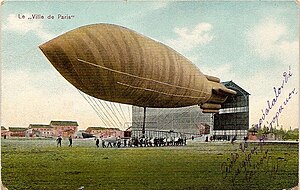La Ville de Paris (airship)
| La Ville de Paris | |
|---|---|
 |
|
| Role | Experimental dirigible |
| Manufacturer | Édouard Surcouf |
| First flight | November 11, 1906 |
| Primary user | French Army |
| Number built | 1 |
The Ville de Paris was a dirigible constructed in 1906 for Henry Deutsch de la Meurthe by Édouard Surcouf.
La Ville de Paris was the second airship of this name commissioned by Deutsch de la Meurthe: the first, built in 1902-3 and constructed by Maurice Mallet and designed by Victor Tatin was unsuccessful.
The airship was designed by the prominent balloon manufacturer Édouard Surcouf and Henri Kapferer. It was powered by a 70 hp 4-cylinder Argus engine driving a single propeller at the front of the nacelle via a 5:1 reduction gearbox. The engine also drove a pump to maintain pressure in the internal ballonet. The nacelle was a square-section wire-braced wooden structure which had been used in the unsuccessful design of 1902, and carried a pair of rudders at the rear and a pair of biplane elevators. The most novel feature of the design were the tail surfaces, which consisted of elongated tubes inflated with hydrogen. These were the result of research carried out by Charles Renard.
After trim trials on 23 October 1906 and a tethered engine trial on 27 October, La Ville de Paris made its first flight on 11 November 1906, piloted by Surcouf and Kapferer, with Louis Paulhan as mechanic. The flight was marred by problems with the engine, and after crossing the Forest of Saint-Germain the airship was landed at Chambourcy after 1 20 m in the air, after which it was deflated and returned by road to Sartrouville.
Following this flight it was decided to replace the four-year-old keel structure because of the state of the wood from which it was constructed. A second pair of elevators were added amidships: these were constructed by Voisin Freres, as was the propeller. The Argus engine was replaced by a Chenu of the same power.
...
Wikipedia
